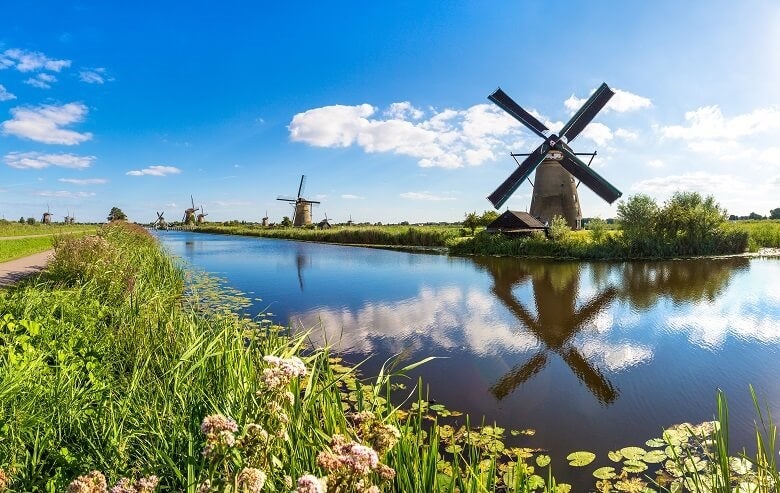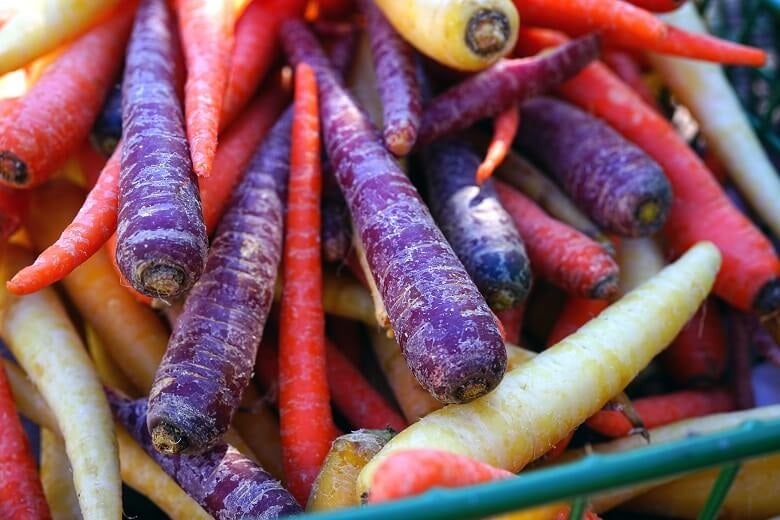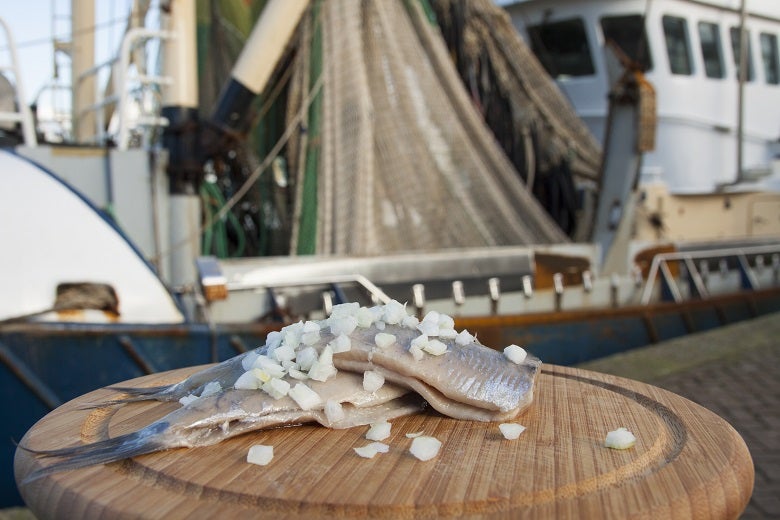21 Things You Should Know Before Moving to the Netherlands
Hallo! We’ve got things to tell you about the Netherlands. If you’re moving over there, you should be ready for a real Dutch surprise. There’s a lot more to the nation than clogs and windmills (although there is still a lot of clogs and windmills). We’re talking about one of the most unique countries in Europe, full of tall, healthy, straight-talking people with a weird love for the colour orange. Let us take you through the key points of Dutch culture, from dikes and bikes to hagelslag. Enjoy!

An iconic Dutch windmill in a sunny Dutch meadow
Select the size of your move to get free quotes
1. Don’t call it Holland
Calling the Netherlands ‘Holland’ is like calling the United Kingdom ‘Yorkshire’. It’s slightly faster to say but it’s also just plain wrong. Holland is a region that takes up about one third of the Netherlands, so if you say ‘Holland’ then you’re ignoring the other two thirds of the country. What about poor Groningen? Utrecht? Limburg? We could go on (there are 12 regions in total). The one exception appears to be the Dutch football team, who are still sometimes known as Holland. Even the Dutch fans chant “Holland, Holland, Holland”. We don’t think anyone has the heart to tell them.
2. It’s very low
There’s an old saying that goes “while God created the Earth, the Dutch created the Netherlands”. What do you do when you want a bigger country? You push the sea back. The Netherlands is a fairly small place but it should be even smaller. For nearly one thousand years, the Dutch have been draining land and reclaiming it back from the sea. They use pumps and windmills to drain the water, and then build big barriers along the coast (known as ‘dikes’) to stop the sea from taking it back again. Over a quarter of the Netherlands should technically be underwater and only 50% of the country is more than a metre above sea level. They’re playing a dangerous, watery game. If you’re wondering, “Netherlands” literally means “lower countries”.
3. There ain’t no mountain high enough
The Dutch landscape is famously flat. The lowest point in the country is 22 feet below sea level (Prince Alexander Polder) and the highest point is only 1000 feet above sea level (the Vaalserberg), while most of the space in between is just a big green pancake. Positives: you can see for miles and you don’t have to cycle up any steep hills. Negatives: it makes everywhere really windy and you don’t get to cycle down any steep hills.
4. They’re bicycle crazy
Name a more iconic duo than the Netherlands and the bicycle. They’ve been getting along for years and now bicycles actually outnumber people over there (22.5 million bicycles vs 18 million people). It’s lovely but also a bit sinister. Loads of car-bike collisions in the 1970s caused uproar amongst the Dutch, so the response was to create a system where bicycles (or fiets) have priority. There’s now a 35,000 km network of bike paths across the country and car drivers just need to deal with it. On roads, on roundabouts, in the city and in the countryside: the bike is always right. If you want to go Dutch then be prepared to pedal your socks off.
5. There’s great healthcare
The final piece of the puzzle! There are three key reasons the Dutch are so fit and healthy: exercise, diet, and a brilliant healthcare system. It’s all about the basisverekering.
This is a compulsory health insurance scheme that costs each person around €95-€120 per month, and it’s very efficient. In 2024, the Euro Health Consumer Index (which ranks healthcare services) gave the Netherlands second place (just behind Switzerland). Meanwhile, the UK managed a measly 16th. The Dutch doctors will do all they can to keep you from popping your clogs.
Before your big move to the Netherlands, it’s wise to think about medical cover for when you’re out there.
That way, you’ll be prepared when you arrive.

A bright red bicycle leans by a railing in Amsterdam
6. Their food is super healthy
All that cycling energy must be coming from somewhere. Back in 2014, Oxfam’s ‘Good Enough to Eat’ Index ranked all the world’s countries based on their diet (nutrition, health, affordability etc) and the Netherlands came first. In fact, 19 of the top 20 countries were in Europe, but nobody came close to the Dutch. For hearty grub and proper nosh, look no further than life in the Netherlands.
7. They are extremely tall
Here’s more evidence that the Dutch are eating well. The people of the Netherlands have made up for living in such a low country by growing incredibly tall. Research from the journal eLife in 2016 showed Dutch men to be the tallest in the world, averaging a height of 183 cm, or a little over six foot. We’re not sure yet as to how the Dutch are going to make use of this superpower, but it’s very exciting for them. The potential of 8.5 million tall men is enormous.
Select the size of your move to get free quotes
8. The schools have got it right
Children are the future and the Netherlands have taken this very seriously. In the World Economic Forum’s 2016 ranking of school systems around the world, the Netherlands came fifth (it came fourth in this list). It’s not top of the class, but nobody likes a teacher’s pet. Plus, Unicef have found Dutch kids to be happiest in the world, so the children learn a lot and have fun while they’re doing it.
9. The Dutch really know their Engels
Try as hard as you like, but any attempt to speak to a Dutch person in Dutch will almost inevitably result in them replying to you in English. If they can tell that you’re not a native, they won’t waste any time letting you speak their language. This is really annoying for people who go to the Netherlands to practice their Dutch. According to the worldwide English Proficiency Index, the Netherlands has the highest proficiency of English as a second language than any other nation. However, it’s not just down to the schools; none of the English or American cartoons are overdubbed on Dutch television, so kids have got to learn their Engels fairly quickly if they want to have a fun childhood.
10. Honesty is the best policy
They might speak a lot of English, but the Dutch don’t behave like the English. In the UK we call it politeness, in the Netherlands they call it weakness. The Dutch are honest, blunt and direct – and they’re proud of it. If you’re Dutch and you’ve got something on your mind, you say it. You never need to worry about what people secretly think about you because they will have told you already. It’s a beautifully transparent and slightly painful system. If you’re used to English manners, a day of Dutch directness will well and truly bowl you over. To make things even less English, people in the Netherlands also hate queuing. When the bus or the train arrives, your elbows had better be ready.

An aerial view of the Dutch city of Rotterdam
11. They have great sayings
While you don’t need to learn any Dutch to get by in the Netherlands, the language comes with some wonderful phrases. Learn a few of these and you’ll be dispensing wisdom to your Dutch friends in no time. If something unfortunate happens to you or a pal, just say ‘helaas pindakaas’ (‘too bad, peanut butter’), which means ‘no worries’, of course. You could also try telling them ‘de molen gaat niet om met wind die voorbij is’ (‘the windmill doesn’t care for the wind that’s gone past). If someone reveals a secret to you, loudly shout ‘nu komt de aap uit de mouw’ (‘now the monkey comes out of the sleeve’)! You might need to ‘met de deur in huis vallen’ (‘to fall with the door into the house’), which is what you say when you’re about to be blunt with someone. That phrase will come in fairly handy in the Netherlands.
12. Some of them speak Frisian
There are actually two official languages in the Netherlands: Dutch and Frisian. You may have heard of the cows, but it’s also a very, very old language. Frisian comes in three different categories: North Frisian, Sater Frisian and West Frisian. While the first two belong in Germany, West Frisian is a Dutch thing, spoken by about 400,000 people mostly in the northern province of Friesland. The Netherlands are doing the best they can to preserve it, making sure it’s still taught in Friesland schools. Weirdly, Frisian is the closest living language to English, and the English language owes quite a lot to the Frisians, eg. ‘see’ (‘sea’), ‘stoarm’ (‘storm’), ‘froast’ (‘frost’), ‘rein’ (‘rain’), ‘mist’ (‘mist) and so on. Basically, the English wouldn’t be able to talk about all their miserable weather without help from the Frisians.
13. Orange fever is everywhere
It was Frank Sinatra who said “orange is the happiest colour”. If that’s true, then you’re sure to feel happy in the Netherlands, because the Dutch just love the colour orange. It all started a long time ago in the 17th century when William of Orange took the throne, and everyone realised what a wonderful, jazzy colour orange was. Today, the Dutch only need to slightest excuse to turn their whole country into a dazzling explosion of bright orange. International sport events (especially football matches) are a popular time for oranje to appear, along with Koningsdag, the annual holiday that celebrates the king’s birthday. You probably haven’t realised, but we’re all part of this oranjekoorts (‘orange fever’). If it wasn’t for oranjekoorts, we’d all be eating purple and yellow carrots. The Dutch developed the orange carrot in the 17th century by adding more beta carotene (a natural orange pigment), and then grew so many that everyone basically forgot about the other types of carrot.

Some of the colourful carrots you’re missing out on
14. They’re big on LGBT rights
The Dutch got there first. In December 2000, the Netherlands became the first country to legalise gay marriage, leading the way for nations all over the world. If there’s anything brighter and more fun than the colour orange, it’s the funky rainbow flags that fly over Amsterdam during its annual Pride Festival (28th July to 5th August). The atmosphere is electric and the famous Canal Parade is jolly good fun to watch. According to LGBT rights group COC, about 90% of people in the Netherlands currently have a positive attitude towards LGBT people, compared to 53% in 2006. Those are some wonderful gains right there.
15. Marijuana isn’t actually legal
Despite what everyone tells you, marijuana is not technically legal in the Netherlands. However, the laws surrounding weed are fairly hazy, and a small amount of it is “tolerated”. If the Dutch police catch you with marijuana, you’re very unlikely to get in trouble if it’s less than five grams. The ‘coffee shops’ of Amsterdam are technically illegal, but they also get given trade permits by the authorities. Doesn’t sound very illegal, does it? Coffee shops can store up to 500 grams of the green stuff at any time, but if they exceed this amount they’ll be in trouble. We’re surprised the Dutch haven’t started growing bright orange marijuana.
16. You can’t get a pint
The Netherlands love their beer as much as the next country, but they drink it with a little more finesse and style. Instead of buying beer in pints, they put it into smaller glasses called fluitjes (‘little flute’, 0.20l) and vaasjes (‘little vase’, 0.33l). A pint is really an unnecessarily large amount of beer, and flutes and vases sound much more classy. It makes perfect sense: the smaller glasses help to keep beverages fresher and it stops people getting really drunk too quickly. A Dutch beer is best enjoyed in one of the traditional Dutch pubs, known as bruin kroegs (‘brown pubs’), and they really are just spectacularly brown.
17. National dish? Raw fish!
If you’re ever feeling hungover, give this traditional Dutch remedy a try. Raw herring and raw onions wrapped up in bread is the national dish of the Netherlands, and it used to be the go-to meal for Dutch people after a big night. To prepare broodje haring, you cut off the head and the gills of the herring but leave the tail on. Then you cure it with salt, leave it for a day and it’s ready. If you’re feeling so hungover that you can’t be bothered to chew, broodje haring is so soft that you can practically slurp it down without using your teeth. Delicious and practical. You’ll find street carts in every Dutch city selling broodje haring. If you can’t see any then just follow the beautiful smell.

Raw and ready to eat: a plate of fresh broodje haring
18. They love their koffie
If you think the UK consumes a lot of coffee, you should take a look at the Netherlands. The Dutch absolutely gulp it down. In 2017, the International Coffee Organisation found the Netherlands to be the fifth biggest coffee drinkers in the world, necking 8.4kg per capita per year. The UK weren’t even close to the top 20, consuming just 2.8kg. Not that it’s a competition or anything.
19. Adults eat sprinkles for breakfast
There’s a child in all of us. The Netherlands have a thing called hagelslag and it’s enormously popular. In the morning, fully grown men and women eat hundreds & thousands for breakfast. They spread some butter on their toast and then chuck loads of colourful sprinkles all over it. ‘Hagelslag’ literally translates into ‘hailstorm’. Sweet, sugary hail. You can get about 20 different flavours of hagelslag, including chocolate, forest fruits and gingerbread. There’s also a very special type of hagelslag called ‘muisjes’ (‘mice’), which is used to celebrate the birth of a baby. Muisjes is basically aniseed sprinkles, coloured pink if it’s a baby girl and blue if it’s a baby boy. Overjoyed parents sit around and chomp on these sugar-coated pellets while they chat about how happy they are. The Dutch consume about 14 million kilos of hagelslag each year, which is about the same as one hundred blue whales. And yes, of course they’ve made orange muisjes.
20. Amsterdam is built on poles
Here’s a slightly concerning fact for you: the ground under the Dutch capital is so soft that the city shouldn’t really be there. The whole place is built on a huge number of poles and all the buildings are very slowly sinking. Each pole goes through about 11 metres of soft clay and peat before hitting a solid layer of sand. The Royal Palace in Dam Square is resting on a staggering 13,659 wooden poles. Even several trees in the Vondelpark have poles underneath them. All the houses in the centre are tightly packed together as a way of helping them support each other. That’s why you’ll see houses on the ends of rows looking like they’re struggling a little bit. If you’re buying a property in Amsterdam, try to avoid the ones with bloated walls.
21. You’ll need a kringloopwinkel
Most properties in the Netherlands come unfurnished, and this can often include things like carpets, curtains, light fittings and fridges. Until you’ve got to work on your new place, you’re basically living in a cave that everyone can see into. This is where kringloopwinkels, or recycle shops, come in handy. These places are full of used furniture and old appliances at super low prices. You’ll find them all over the country, and there’s even an online database that tells you where they are. One visit to a kringloopwinkel and you’ll never buy new again.
Transferring money to the Netherlands
If you’re thinking of moving to the Netherlands and/or buying property there, you’ll need to convert your money into euros.
That’s why we’ve teamed up with Wise, an easy-to-use international money transfer service which uses the real exchange rate, and charges low fees.
Fill out Wise’s form below to see how they could help.
Hopefully your enthusiasm for all things Dutch has gone through the roof. Life in the Netherlands is one big coffee-fueled bike-riding orange bonanza – and you can be a part of it.
If you’re ready to start the process of moving to the Netherlands, we can help. Simply fill in our form with a few details about your move, and we’ll connect you with our experts supplies. They’ll contact you with bespoke, obligation-free shipping quotes for you to compare.







